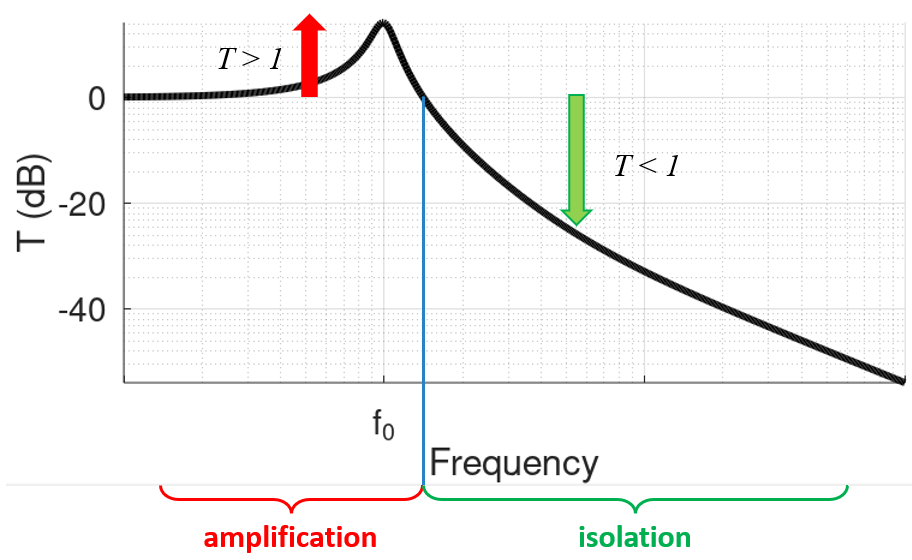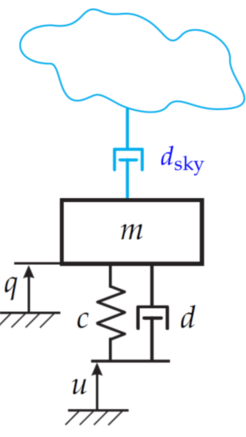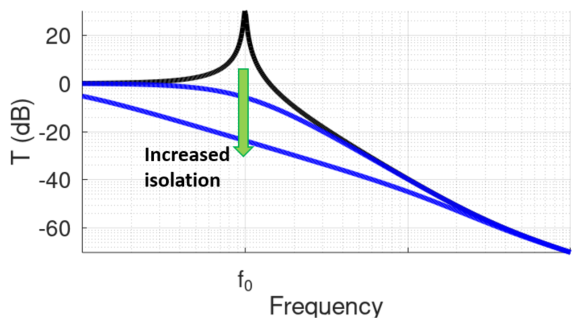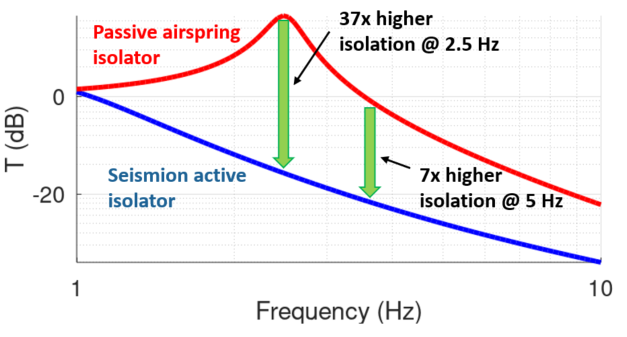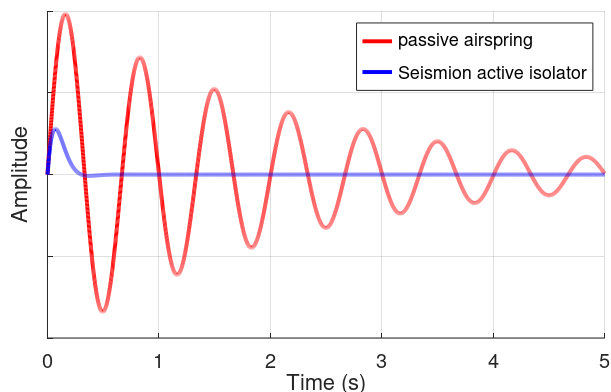Active vibration isolation
Vibration isolation
Numerous applications require for proper operation an installation that is as vibration-free as possible. High-precision measuring systems such as white-light interferometers, scanning electron microscopes or high-magnification microscopes for optical control are influenced by vibration excitation. The same applies to production plants, for example in the semiconductor sector. In addition to good isolation, fast transient response is of great importance here, because this can increase throughput, among other advantages.
Vibration isolation means the decoupling of a platform from the ambient vibrations. The ambient sources include, in particular, building vibrations and foundation vibrations, which are stimulated by foot fall impact, wind forces and road and train traffic. Production machines, printers, elevators and air conditioning systems also lead to a great amount of vibration excitation. These building vibrations occur particularly in the low-frequency spectrum between 2 and 5 Hz, depending on the shape and height of the building and the excitation sources.
The aim of vibration isolation is to reduce these existing vibrations as much as possible so that only a fraction remains on the isolated platform (Figure 1). The so called transmissibility can be used to classify this performance. It refers to the ratio of the vibration amplitudes of the isolated top-plate to those of the base. A value of 1 means that both amplitudes are equal and there is no isolation. A value of 0.1 or 10% indicates that the amplitudes are reduced by a factor of 10 and only 10% of the excitation is still present on the isolated platform. Transmissibility is usually given in decibels (dB). This corresponds to a logarithmic representation. The above exemplary numbers of T=1 and T=0.1 correspond to 0 dB and -20 dB. An even higher isolation to T=0.01=1% corresponds to -40 dB.
Vibration isolators, regardless of whether they are passive or active, exhibit a frequency-dependent transmissibility. This means that the isolation at 2 Hz, for example, would not be the same as at 10 Hz or at 30 Hz. Therefore, the transmissibility is typically given as a graph versus the frequency axis.
FIgure 1: Schematic of vibration isolators
Passive vibration isolators versus active vibration isolators
Despite the fundamental differences in the internal design of passive and active isolators, the transmissibility curves are basically very similar. A typical curve is shown in Figure 2.
The transmissibility curve is characterized by a significant peak at the resonance frequency. At that frequency, the isolator actually amplifies the transmission of vibrations. For lower frequencies, the transmissibility approaches the value of 1 (0 dB), and above the resonance, the transmissibility is declined more or less.
The frequency range can therefore be divided into an amplification range and an isolation range, with the isolation range beginning above the resonance frequency (to be precise, at 1.41 times the resonance frequency). For this reason, the resonance frequency of isolators is an important design criterion, which should be as low as possible. Typical air spring isolators achieve resonances of approx. 2.5 Hz and isolate from 3.5 Hz. With simple rubber buffers, the isolation only occurs above 10 or 15 Hz.
The effect of the damping can be seen in Figure 3. While the resonance amplification is reduced by damping – but still remains above 1 and thus amplifying ground vibrations – the isolation is strongly diminished because the transmissibility is more flatly shaped. High isolation velues like -40 dB are therefore hardly reached. When choosing the damping, there is a conflict of goals that cannot be resolved in a passive manner.
Active vibration isolators such as the Seismion Reactio are also mechanically based on an elastic mount. However, there is also an active control system, which is set up as a classic feedback control. Especially developed acceleration sensors with piezoelectric ceramics monitor the amplitudes of the isolated platform with high precision. These measured signals are converted into the required actuation forces by an analog control system, which drive contact-less voice coil actuators. Multiple of these active control loops are in action in order to isolate all six degrees of freedom.
The basic idea of active control is to reproduce a so-called „sky-hook damper“ (Figure 4). Unlike in the passive system, this damper is not coupled to the (vibrating) floor, but to a virtual, stationary attachment point. Therefore, no further disturbances from the ground are introduced into the system via this virtual damper, and the sky-hook damper only has advantages for isolation and stabilization purpose. The corresponding transmissibility curves in Figure 5 show that the resonance can be completely suppressed by the sky-hook damping, and the isolation begins at significantly lower frequencies.
An ideal sky-hook damper is practically impossible to realize for several reasons. Active systems therefore also posses resonance amplifications, which, however, are well below 1 Hz in the case of Seismion isolators.
FIgure 2: Typical transmissibility curve and isolation range
FIgure 3: Influence of damping upon transmissibility curve
FIgure 4: Schematic representation of a shyhook damper
FIgure 5: Transmissibilities of ideal skyhook damper systems
Performance comparison of passive and active isolators
In order to compare the isolation performance of the Seismion Reactio Isolator with that of typical air spring systems, both transmissivities are shown in Figure 6.
It is immediately apparent that the Seismion Reactio isolators isolate much better due to the low resonance frequency. Especially in the critical frequency range of 1-10 Hz, the isolation is 7 times better than with state-of-the-art air springs. In the range of air spring resonances at 2.5 Hz, the Reactio isolators are even 37 times better!
Improvement of settling time
Equally impressive are the differences in settling time. This is the time it requires for the system to return to its resting position after it has been excited. This reveals a major disadvantage of passive vibration isolators such as air springs: since the isolation is relying on a weak transmission path of ground excitation through the spring c and the damper d (see Fig. 4), there is inevitable less stability with direct excitation. As a result, an air spring system oscillates for a very long time, Figure 7. Due to the weak damping, the system needs numerous periods to settle. Significant vibrations are still present even after 5 seconds.
In comparison, active Reactio isolators have very good stability properties. This is due to the fact, that isolation is not based on a very soft and weakly damped mount, but rather from sky-hook damping. With direct excitation, the very effective Sky-hook damper counteracts the vibrations and brings the system almost immediately to rest. These properties are particularly advantageous for XY portals, such as surface scanners, roughness measurements and all applications where the user interacts directly with the application.
Advantages of active vibration isolators
As a user of our Reactio isolators, you will immediately notice the enormous increase in isolation as well as in stabilization:
- this allows high-precision measurements, even in environments that are unsuitable for conventional air springs due to the high level of disturbance
- you are well prepared for future developments and trends, which are characterized by smaller sizes and higher precision requirements
- your production machines can run at higher cycle rates because the settling time of the Reactio isolators is also significantly improved compared to air springs
FIgure 6: Comparison of isolation performance of air spring isolators and active Seismion Reactio isolators
FIgure 7: Comparison of settling times for air spring isolators and active Seismion Reactio isolators


